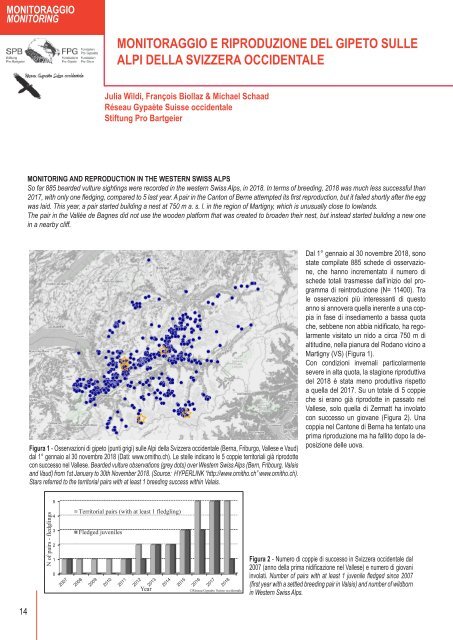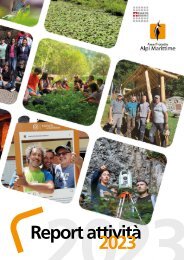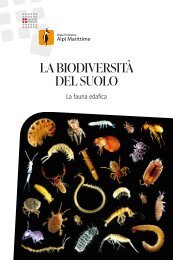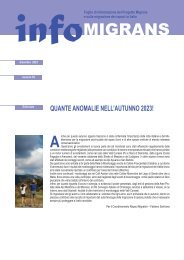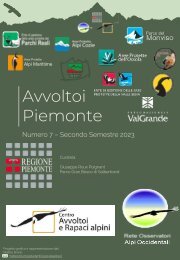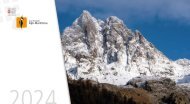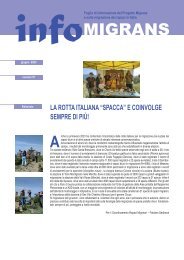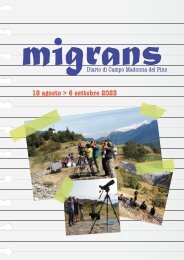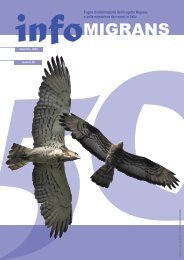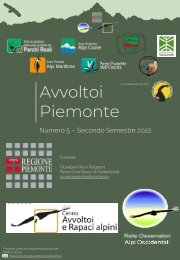infoGIPETO n.35 | dicembre 2018
Periodico d'informazione sul progetto di reintroduzione del gipeto.
Periodico d'informazione sul progetto di reintroduzione del gipeto.
You also want an ePaper? Increase the reach of your titles
YUMPU automatically turns print PDFs into web optimized ePapers that Google loves.
MONITORAGGIO<br />
RIPRODUZIONE MONITORING IN NATURA<br />
MONITORAGGIO E RIPRODUZIONE DEL GIPETO SULLE<br />
ALPI DELLA SVIZZERA OCCIDENTALE<br />
Julia Wildi, François Biollaz & Michael Schaad<br />
Réseau Gypaète Suisse occidentale<br />
Stiftung Pro Bartgeier<br />
MONITORING AND REPRODUCTION IN THE WESTERN SWISS ALPS<br />
So far 885 bearded vulture sightings were recorded in the western Swiss Alps, in <strong>2018</strong>. In terms of breeding, <strong>2018</strong> was much less successful than<br />
2017, with only one fledging, compared to 5 last year. A pair in the Canton of Berne attempted its first reproduction, but it failed shortly after the egg<br />
was laid. This year, a pair started building a nest at 750 m a. s. l. in the region of Martigny, which is unusually close to lowlands.<br />
The pair in the Vallée de Bagnes did not use the wooden platform that was created to broaden their nest, but instead started building a new one<br />
in a nearby cliff.<br />
Figura 1 - Osservazioni di gipeto (punti grigi) sulle Alpi della Svizzera occidentale (Berna, Friburgo, Vallese e Vaud)<br />
dal 1° gennaio al 30 novembre <strong>2018</strong> (Dati: www.ornitho.ch). Le stelle indicano le 5 coppie territoriali già riprodotte<br />
con successo nel Vallese. Bearded vulture observations (grey dots) over Western Swiss Alps (Bern, Fribourg, Valais<br />
and Vaud) from 1st January to 30th November <strong>2018</strong>. (Source: HYPERLINK “http://www.ornitho.ch” www.ornitho.ch).<br />
Stars referred to the territorial pairs with at least 1 breeding success within Valais.<br />
<br />
Dal 1° gennaio al 30 novembre <strong>2018</strong>, sono<br />
state compilate 885 schede di osservazione,<br />
che hanno incrementato il numero di<br />
schede totali trasmesse dall’inizio del programma<br />
di reintroduzione (N= 11400). Tra<br />
le osservazioni più interessanti di questo<br />
anno si annovera quella inerente a una coppia<br />
in fase di insediamento a bassa quota<br />
che, sebbene non abbia nidificato, ha regolarmente<br />
visitato un nido a circa 750 m di<br />
altitudine, nella pianura del Rodano vicino a<br />
Martigny (VS) (Figura 1).<br />
Con condizioni invernali particolarmente<br />
severe in alta quota, la stagione riproduttiva<br />
del <strong>2018</strong> è stata meno produttiva rispetto<br />
a quella del 2017. Su un totale di 5 coppie<br />
che si erano già riprodotte in passato nel<br />
Vallese, solo quella di Zermatt ha involato<br />
con successo un giovane (Figura 2). Una<br />
coppia nel Cantone di Berna ha tentato una<br />
prima riproduzione ma ha fallito dopo la deposizione<br />
delle uova.<br />
5<br />
N of pairs - fledglings<br />
4<br />
3<br />
2<br />
1<br />
0<br />
Territorial pairs (with at least 1 fledgling)<br />
Fledged juveniles<br />
Year<br />
©Réseau Gypaète Suisse occidentale<br />
Figura 2 - Numero di coppie di successo in Svizzera occidentale dal<br />
2007 (anno della prima nidificazione nel Vallese) e numero di giovani<br />
involati. Number of pairs with at least 1 juvenile fledged since 2007<br />
(first year with a settled breeding pair in Valais) and number of wildborn<br />
in Western Swiss Alps.<br />
14


